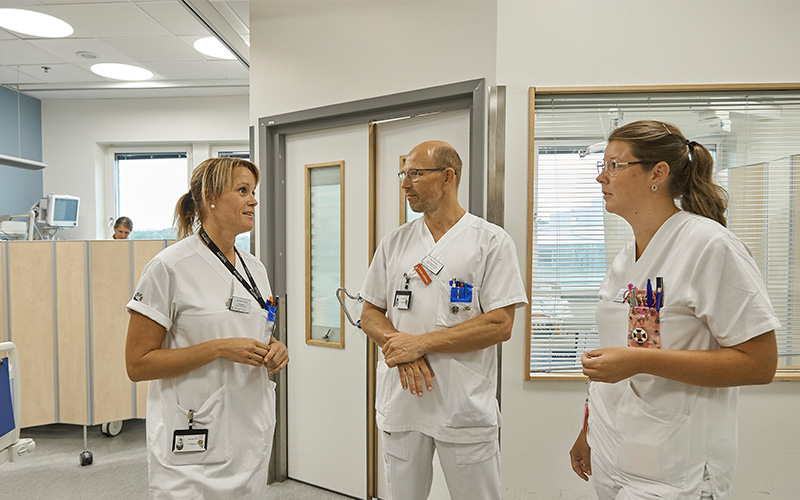Circadian lighting has proven to be an effective treatment for hospitalized patients and individuals with dementia. However, in order to ensure optimal results, a new research project is now focusing on the importance of implementation and how the light affects healthcare personnel.
Research conducted at Rigshospitalet has revealed that a Danish-developed circadian lighting system reduces depression, anxiety, sleep disturbances, and fatigue in hospitalized patients. As a result, some hospitals and nursing homes have integrated circadian lighting as a crucial part of patient care and treatment. This has created a need to examine and systematize the implementation of circadian lighting.
— The implementation defines how the lighting is used and therefore has a direct impact on its effectiveness. So, to ensure positive outcomes, the implementation process is crucial, says Kathrine M. Schledermann, a PhD student in Business.
Kathrine M. Schledermann will lead a new research project that focuses on implementation and effectiveness.
Method validated through research
In addition to developing a research-based method for implementing circadian lighting for Chromaviso, the project aims to document the impact on the healthcare personnel working with Chromaviso's circadian lighting system.
— Experiences from hospitals and nursing homes have shown that circadian lighting brings about a significant change in the daily lives of both patients and healthcare personnel. They notice the impact it has on their sleep, mood, and overall well-being, while also adapting to new habits and behavioural patterns. The automatic sunrise and sunset, for instance, influence morning and evening routines. This adjustment period is crucial, and it is important for the staff to understand the rationale behind the lighting in order for the change to be embraced positively and spread effectively, explains Kathrine M. Schledermann.
The research-based implementation method will be developed based on in-depth investigations into the barriers and challenges that are relevant to the success of implementation. At the same time, the study will follow a number of hospitals and nursing homes in Denmark and Sweden using Chromaviso's circadian lighting, both before, during, and after installation.
— Implementation has always been a crucial aspect of our solutions, integral to ensuring high user satisfaction. Given that our lighting has been extensively researched and is now being used as a treatment, it places additional demands on our implementation process. By employing a research-based method, we guarantee that the documented effect becomes a reality in all our projects, explains Anders Kryger, CEO of Chromaviso.
The role of healthcare personnel is important
The interest in the impact on healthcare personnel has emerged following the results at Rigshospitalet regarding patients. More and more hospitals and nursing homes are placing increasing emphasis on recruiting and retaining their staff.
— The feedback on Chromaviso's circadian lighting system indicates that it promotes well-being, employee satisfaction, improves sleep, and reduces sick leave. In this study, we aim to further document the impact on the healthcare personnel and explore its connection to implementation, says Kathrine M. Schledermann.
For instance, Odense Municipality has assessed the impact of Chromaviso's circadian lighting at Herluf Trolle Nursing Home. The study revealed that sick leave was reduced by approximately 20%.
— We are increasingly recognizing the importance of prioritizing the needs of healthcare personnel alongside those of patients. Hospitals and nursing homes are now opting for circadian lighting to enhance the working environment for their staff. Consequently, research findings on the impact of circadian lighting on healthcare personnel become a crucial catalyst for further expansion of its use, as explained by Anders Kryger.

Interdisciplinary research
The research project is a 3-year industrial PhD study, and the findings will be continually published in international journals and presented at prestigious conferences.
— With the positive results seen in patients, it is now crucial for research to investigate the impact of circadian lighting on healthcare personnel and the significance of its implementation. Implementing circadian lighting in highly sensitive environments requires a new interdisciplinary approach that combines anthropological fieldwork with in-depth qualitative research, complemented by quantitative measurements. This study will provide a more nuanced understanding of circadian lighting, whether it is used in a hospital setting for treatment purposes or in elderly care to enhance the quality of life, explains Michael Mullins, Associate Professor at Aalborg University.
For Chromaviso, the study is a key component of the company's international scaling strategy.
— Research and documentation serve as the gateway to international markets. With this project, we are building upon our existing knowledge of how we promote health for patients. We are proud to be the first to provide documentation on both personnel and implementation, says Anders Kryger.
Objective
A three-year industrial PhD project aimed at investigating the barriers and challenges of implementing circadian lighting, developing a research-based method for implementation, and examining the effects of circadian lighting on healthcare personnel in terms of job satisfaction, workflow, and sick leave. This study will include participation from both Danish and Swedish nursing homes and hospitals using Chromaviso's circadian lighting system. The initial results are expected to be available in 2021.
Method
The study will combine both qualitative and quantitative research methods to achieve a comprehensive analysis. By adopting an anthropological approach with field studies, qualitative interviews and observations in hospitals and nursing homes will be supplemented with quantitative surveys.
Participants
The project is a collaboration between Chromaviso and Aalborg University, with support from Innovationsfonden. Chromaviso, a leading expert in health-promoting lighting, has been involved in over 100 projects throughout Scandinavia.

